|
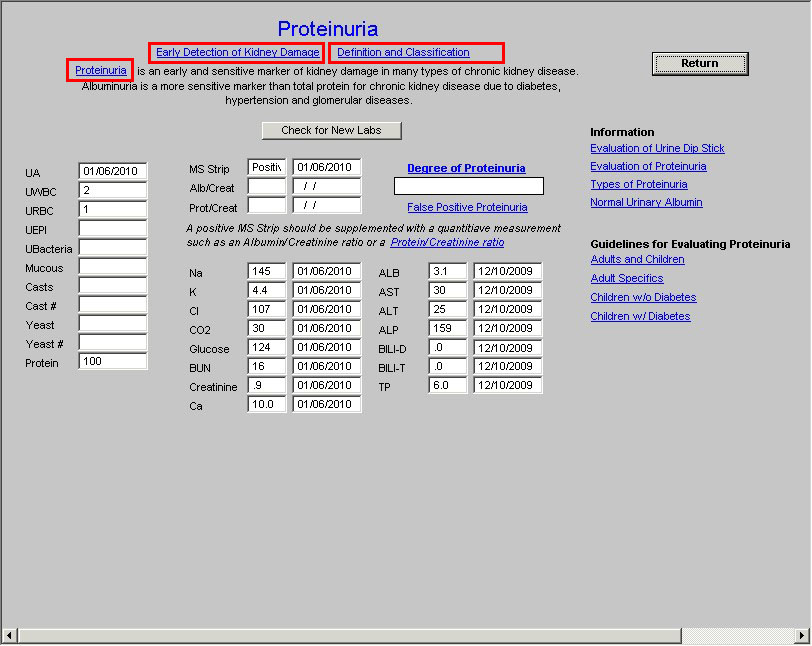
At the top of the Proteinuria template are two buttons which give information about the early detection of kidney damage and definitions of proteinuria and albuminuria.
The first button is entitled “Early Detection of Kidney Damage.” When it is launched the following is displayed.
Early Detection of Kidney Damage
- Early detection: Persistently increased urinary excretion of protein is a sensitive marker of kidney damage. Early detection allows more timely introduction of therapy to slow disease progression.
- Albuminuria is more sensitive marker for adults with CKD due to diabetes, hypertension, and glomerular diseases than total protein.
- NKF recommends random spot urine measurements due to the inconvenience and errors associated with timed- urine samples.
- First morning specimens are preferred: if not available, random specimens are acceptable
- If 1+ protein, assess total protein-to-creatinine ratio or albumin-to-creatinine ratio within 3 months.
The second button is entitled “Definitions of Proteinuria and albuminuria.” When this button is activated, the following information appears.
Definitions of Proteinuria and Albuminuria
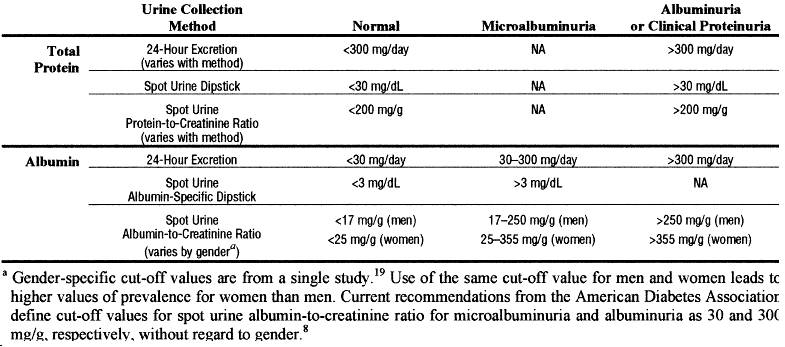
The next hyperlink on this template is entitled Proteinuria and when launched, it displays the following information:
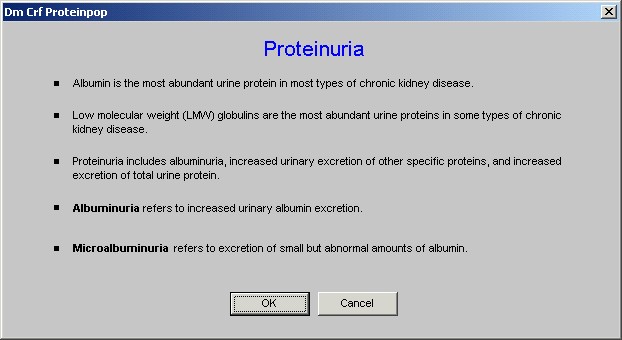
After the hyperlink entitled Proteinuria, there are two facts about proteinuria which are very important:
- Protein is an early and sensitive marker of kidney damage in many types of kidney disease.
- Albuminuria is a more sensitive marker than total protein for chronic kidney disease due to diabetes, hypertension and glomerular disease.
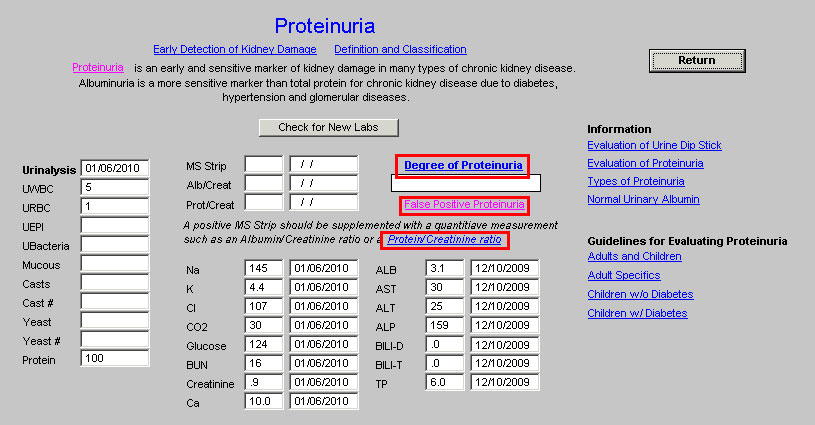
Following these statements, there is a box in which the “degree of proteinuria” is automatically documented.
Note: In order for the “degree of proteinuria” to be calculated an albumin/creatinine ratio or a protein/creatinine ratio must be documented in the lab values.
Above the box entitled “degree of proteinuria,” there is a button of the same name, which when launched displays the following information:
Degree of Proteinuria
normal: < 150 mg/24hr
microalbuminuria: 30-300 mg/24 (specifically albumin; usually measured in diabetics)
trace proteinuria: 150 to 500 mg/24 hr
mild proteinuria: 500 mg to 1 g/24 hr
moderate proteinuria: 1-3 g/24 hr
nephrotic range proteinuria: > 3 g/24 hr
Causes of False Result
Beneath the box in which “degree of proteinuria” is displayed, there is a button entitled, “False Positive Proteinuria.” When this button is clicked, the following pop-up is displayed.
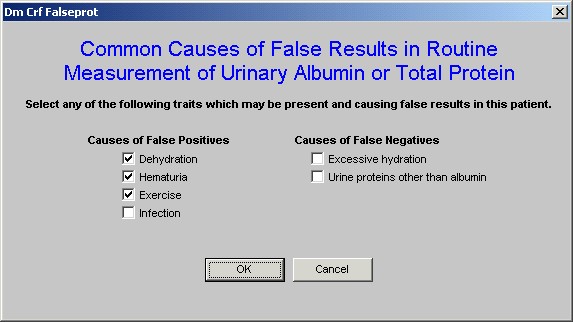
This allows the provider to document the presence of any condition which might influence the measurement of urinary protein and which might give a false value.
Below the Degree-of-Proteinuria box, there is a caution about the MS Strip or Micral Strip. See it below outlined in red.
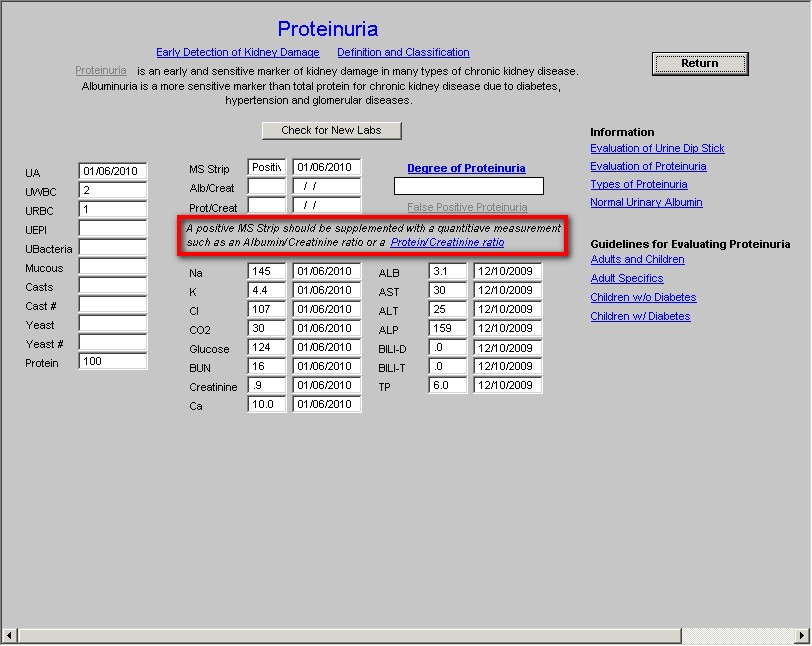
A hyperlink is attached to the phrase “Protein/Creatinine Ratio,” which when launched displays the following:
Evaluation of Proteinuria
Spot protein/creatinine ratio estimates 24-hour excretion of protein in grams/24 hr. To perform the test, a random urine sample is submitted to the laboratory for protein concentration (in mg/dL) and creatinine concentration (in mg/dL). The protein/concentration is divided by the creatinine concentration, and the unit-less number is the estimated daily protein excretion in gm/24 hrs. An abnormal ratio is >0.15, which estimates a 24 hour protein excretion of >150 mg/day (>0.15 gm/day). Many nephrologists recommend using protein/creatinine ratios to quantify protein excretion instead of a 24 hour urine collection.
Beneath this information is a display of 15 lab values pertinent to Proteinuria evaluation.
To the right of this information there is a series of information buttons which launch documents on:
- Evaluation of Urine Dip Stick
- Evaluation of Proteinuria
- Types of ‘Proteinuria
- Normal Urinary Albumin
Followed by a series of articles entitled “Guidelines for Evaluating Proteinuria.”
- Adult and Children
- Adult Specific
- Children without Diabetes
- Children with Diabetes
|